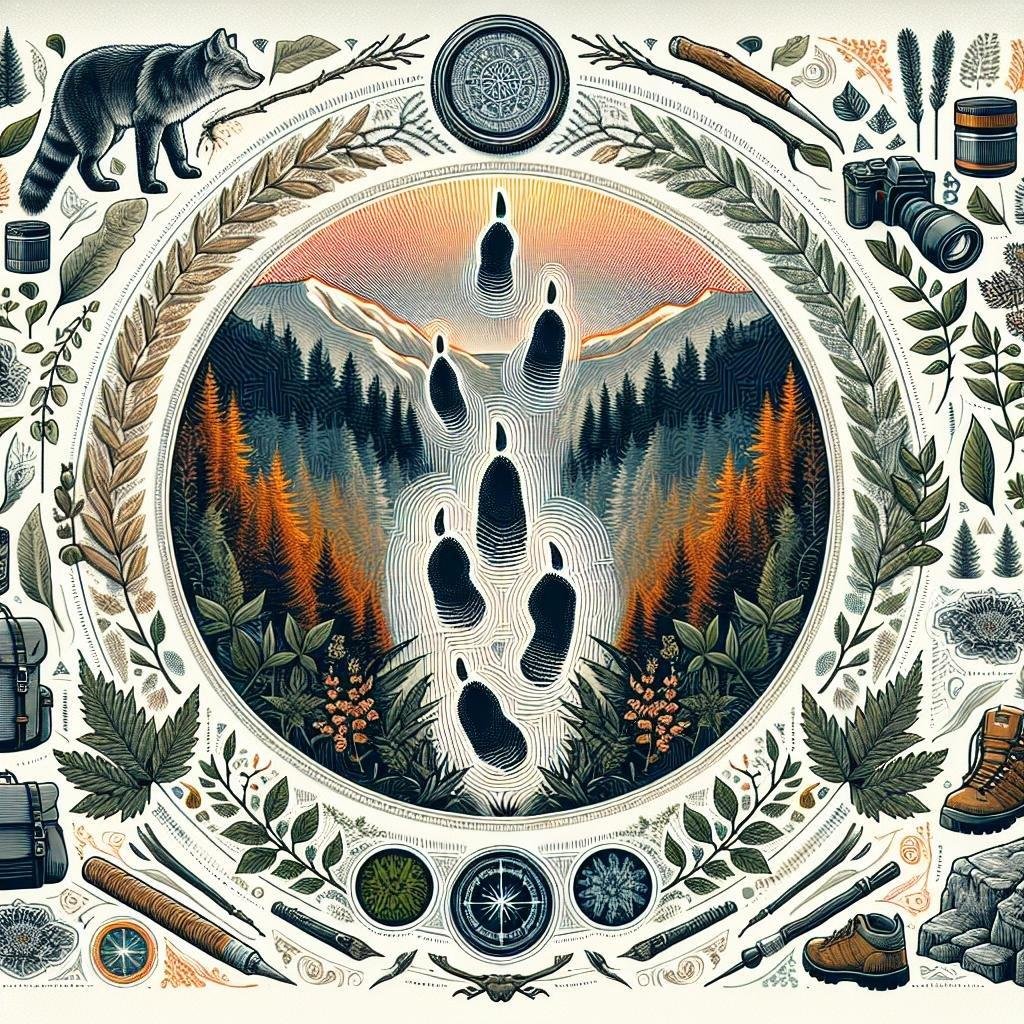Nestled within the verdant embrace of the Appalachian range, the Smoky Mountains beckon adventurers with a unique tapestry of natural wonders. But beyond the sweeping vistas and timeless ridge lines lies a quieter story etched into the earth, where the forest floor is imprinted with tales of elusive wildlife. Welcome to the hidden world of animal tracking, where hiking trails transform into nature’s narrative canvas. In the Smoky Mountains, each trail is a pathway through a living library, where the soft pad of a bear or the delicate step of a deer might tell the story of a day spent roaming the wild. Join us as we explore these remarkable trails, where patience and keen observation reward hikers with the secrets of the unseen residents of this majestic wilderness.
Tracing Wildlife Adventures in the Heart of the Smokies
Venture into the vast wilderness of the Great Smoky Mountains, where each trail is a narrative written by the footsteps of its non-human inhabitants. The enchanting landscape offers a perfect backdrop for nature enthusiasts keen to imbue their hikes with a touch of discovery. As you tread on the scenic Alum Cave Trail, look for white-tailed deer tracks seamlessly interspersed with elk imprints, while the ground remains whisper-quiet beneath century-old hemlocks. This path, extending to the Cove Hardwood Nature Trail, is a renowned corridor for observing the footprints of black bears, identifiable by their broad front paws. Paired with the crisp air, the trail’s gentle incline provides a serene atmosphere to spot nature’s delicate clues.
Further along the Roaring Fork Motor Nature Trail, the chirping of spring peepers heralds excellent opportunities to trace squirrel patterns amidst Raccoon paws leading to the streams. Explorers might come across intriguing wild turkey tracks near the glistening riverbeds, which prove to be a seasonal home for various amphibians. Not only does this trail promise an immersive hike, but it also offers a captivating exploration of the vibrant tapestry of life within the park. Make sure to carry your species guidebook to these trails to enhance your journey from just a hike to an enlightening wildlife adventure.
| Trail Name | Wildlife to Observe |
|---|---|
| Alum Cave Trail | Deer, Elk, Black Bears |
| Roaring Fork Motor Nature Trail | Squirrels, Raccoons, Wild Turkeys |

A Closer Look at Seasonal Movement Patterns
Exploring the Smoky Mountains on foot not only offers breathtaking landscapes but also an opportunity to delve deeper into the intricate patterns of wildlife behavior, particularly the seasonal movement patterns of various animals. As the seasons change, so does the scenery along the trails, and tracking becomes more than a hobby—it’s a journey through the meticulous artistry of nature itself. Animal tracks can tell us a story; they highlight the migration paths of deer, the leisurely wanderings of bears, and even the subtle trails left by the elusive bobcats. Observers keen to witness these seasonal movements firsthand have some incredible trails to choose from, each offering its own unique perspective:
- Clingmans Dome: As one of the highest points, the diversity in elevation here offers a mixed variety of tracks as animals navigate the different climates.
- Newfound Gap: Serving as a corridor for wildlife, it’s often bustling with tracks from various species during the seasonal transitions.
- Alum Cave Trail: Known for observable bear tracks as they move between feeding spots, especially in autumn when they’re prepping for hibernation.
To make the most of your animal tracking endeavors, understanding the seasonal flow and preferences of the animals can add another layer of excitement to your outdoor adventures. Here is a brief look at some typical seasonal behaviors of a few key animals found in the Smoky Mountains:
| Animal | Seasonal Movement |
|---|---|
| White-Tailed Deer | Winter migration to lower elevations for warmer climates. |
| Black Bears | Frequent movement in autumn to find rich food sources before hibernation. |
| Bobcats | Active year-round, but tend to roam more at higher elevations during summer. |
By observing these patterns, hikers can gain a richer understanding of the rhythms of the natural world, experiencing the joys and unpredictability that each new trail and season can bring.

Best Trails for Spotting Rare and Abundant Fauna
If you’re eager to experience nature’s pulse firsthand, few places rival the wonder of the Smoky Mountains. This national treasure offers a remarkable array of trails teeming with the whispers of wildlife. Here, you’re not just invited to hike but to embark on a journey of discovery where each track and tread tells a story. Cades Cove Loop Trail is one standout, a 11-mile expedition renowned not only for its scenic beauty but its flourishing wildlife. Deer nibble serenely on the clover, and, if you’re fortunate, a black bear might meander into view. Another jewel, the Alum Cave Trail, doesn’t just lead you through verdant woodlands but opens up a chapter from the Smokies’ ancient narrative, with quaint rabbit tracks often timidly gracing the path amidst nature’s symphony.
- Deep Creek Trail – Follow the bubbling creeks and keep an eye out for the elusive otter gracefully weaving through the water.
- Roaring Fork Motor Nature Trail – A short and sweet adventure where vibrant birdlife paints the sky with joyous colors.
- Little River Trail – Witness the rustling leaves betray the cautious steps of sly foxes and brilliant butterflies.
| Trail Name | Common Sightings |
|---|---|
| Chimney Tops Trail | Red squirrels, salamanders |
| Rainbow Falls Trail | Woodpeckers, chipmunks |
| Froggy Bottoms | Wild turkeys, wood frogs |

Essential Trail Tips for Aspiring Wildlife Trackers
Embarking on a quest to discover and understand animal tracks in the Smoky Mountains offers a rewarding experience for both seasoned naturalists and curious beginners. Before you lace up your boots, consider preparing with a few essential strategies that can transform your hike into a successful wildlife tracking adventure. Firstly, invest in a field guide specific to Smoky Mountain wildlife. This handy resource will assist you in identifying tracks accurately. It’s beneficial to bring along a notebook and pencil to sketch any interesting tracks you find—this helps in comparing your findings later on. To amplify your observation skills, practice reading the landscape; pay attention to habitat types and their likely inhabitants.
Once you’re on the trail, incorporate these key practices to improve your tracking ability:
- Slow and Steady: Move quietly and deliberate your steps to increase your chances of spotting elusive markings.
- Look for Patterns: Pay attention to patterns in the soil, mud, or snow, which can offer significant clues to animal behavior.
- Consider Timing: Early mornings and late afternoons are prime times to discover fresh tracks.
- Stay Safe: While tracking, remain aware of your surroundings to avoid startling wildlife or getting lost.
| Animal | Track Pattern |
|---|---|
| White-tailed Deer | Heart-shaped, with sharp points facing forward. |
| Black Bear | Five toes with visible claw marks, resembling a plantigrade footprint. |
Q&A
Q&A: Hiking Trails for Observing Animal Tracks in the Smoky Mountains
Q1: What makes the Smoky Mountains a good place for observing animal tracks?
A1: The Smoky Mountains offer a rich and diverse ecosystem teeming with wildlife. With over 800 miles of trails winding through lush forests, meadows, and wetlands, the area provides an ideal habitat for many animal species. The variety of landscapes increases the chances of encountering unique and diverse animal tracks, making it a fascinating destination for wildlife enthusiasts.
Q2: Can you recommend some specific trails in the Smoky Mountains for track spotting?
A2: Certainly! One popular trail for observing animal tracks is the Cades Cove Loop. This area, with its open fields and wooded borders, is home to numerous species and often reveals tracks of deer, black bears, and wild turkeys. Another excellent choice is the Little River Trail, where hikers may spot raccoon and bobcat tracks along the riverbanks. Abrams Falls Trail is also noteworthy, boasting bear and deer tracks often seen along its path.
Q3: What kinds of animal tracks might hikers expect to find in the Smoky Mountains?
A3: Hikers can expect to see a wide array of animal tracks. Common tracks include those of white-tailed deer, raccoons, skunks, foxes, and the elusive black bear. If you’re lucky, you might even come across the tracks of a bobcat or an otter near water sources.
Q4: When is the best time of year to find animal tracks in the Smoky Mountains?
A4: The best time to find animal tracks is generally in the early spring or late fall. These seasons often feature softer ground conditions due to rain and melting snow, making tracks more visible. Additionally, fewer leaves cover the tracks during these times, providing clearer impressions. Winter can also be ideal if there’s a light snowfall, revealing fresh tracks.
Q5: Are there any tips for beginners interested in tracking animals during their hike?
A5: Absolutely! Beginners should start by familiarizing themselves with the basic shapes and sizes of common animal tracks in the Smoky Mountains. Bringing along a field guide or a tracking app can be particularly helpful. Be patient and take your time observing the ground and the surrounding environment. Soft mud near water sources or trails after a rain are excellent places to start looking. Lastly, always maintain a respectful distance from wildlife and adhere to park regulations to ensure a safe and enjoyable experience.
Q6: Are there any safety considerations hikers should keep in mind while tracking?
A6: Yes, safety is paramount. Always inform someone of your planned route before heading out and bring a map or a GPS device to avoid getting lost. Be aware of your surroundings, especially when in areas known for black bear activity. Carry bear spray as a precaution and keep noise levels to a minimum to avoid surprising wildlife. stick to marked trails to prevent erosion and damage to sensitive environments.
Q7: Is a permit required for hiking in the Smoky Mountains when tracking animals?
A7: Generally, no permit is required for day hikes in the Smoky Mountains National Park. However, if you plan to camp overnight or hike on certain backcountry trails, you might need a backcountry camping permit. It’s always a good idea to check with the park’s official website or visitor center for the latest information and any potential trail closures or regulations.
Closing Remarks
As we lace up our hiking boots and embark on the echoing trails of the Smoky Mountains, we’re offered more than just a journey through nature’s serene beauty. These paths, laden with the whispers of wildlife, are an open invitation to delve into stories etched into the earth by the creatures that call this landscape home. Whether you’re an experienced tracker or a novice curious about the natural world, these trails open up a dialogue between the seen and the unseen—a tapestry of life waiting to be read and understood. As the sun dips behind the rolling silhouettes of the mountains, may the imprints left behind inspire you to tread lightly and wonder deeply on your next adventure into the wild. Until then, happy tracking.

